
Last updated: 29 January 2003
 |
Last updated: 29 January 2003 |
[12/19/02]
After a month of uncooperative weather since receiving the telescope, I finally had one good night (18 Dec) of clear skies. So I took the LXD55 8" Schmidt-Cassegrain outside for about an hour. The skies were crisp and bright (the Moon was nearly Full). I set up the LXD55 in the GEM Polar Home position. Since I had recently upgraded the Autostar to 2.6Ec using a Power Macintosh G4 Powerbook I decided to train the drives. I selected the Az/RA drive; no adjustments were necessary. I selected the Alt/Dec drive; Polaris (my training target) was not in the field of view of the 26mm eyepiece when the Autostar finished its slewing (in either direction) so I had a long ways to slew to train this drive. I then did an Easy Two Star Alignment. During the slew to the first star the Autostar display blanked out several times and the telescope stop slewing. Much to my surprise the batteries had died! This was only the 3rd time I had the telescope out (not counting the Autostar updating time) so there were only a few hours (less than 10) on those batteries. Maybe they were just weak to begin with. I then connected the Meade #547 AC Power Supply and redid the alignment with no problems.
Since the sky was so bright and my time limited, I decided to just look at Saturn and the Moon and check out some of the eyepieces in the $99 Eyepiece Deal kit.
First up was Saturn, which was one day past its closest opposition in 30 years and nearly at the zenith when I was observing. I started with the standard 26mm eyepiece (77X). Wow! Saturn was extremely crisp and bright. The planet itself was a pale orange with one very evident cloud band. The rings were beautiful (of course) with Cassini Division easily visible. I then decided to really push it so I tried the 6.4mm eyepiece combined with my Meade #126 2X Barlow Lens (which yielded an effective magnification of 625X, exceeding the theoretical maximum of 400X for an 8" by quite a bit). While there was some fuzziness in the image, Saturn was still impressive, with the Ring shadow quite visible on the planet and the planet's shadow visible on the rings. And the thing that surprised me the most was the brightness of the image even at this extreme magnification. I then used the 6.4mm (312X) by itself, which reduced the fuzziness. The only other eyepiece I tried this night was the 12.4mm (161X) and it provided the best view yet.
Next up was the Moon, which was very bright as it was near Full and near the zenith. Due to its brightness I decided to use the Meade #905 Variable Polarizer Filter to reduce the pain of viewing such a bright Moon with such a large telescope. I set the adjustment to full polarization and used the 26mm (77X) to look at the Moon. Wow; the details that were visible were incredible. There was no eye strain or pain to view the Moon. The disk of the Moon was slightly larger than the eyepiece field of view (FOV). I switched to the 40mm eyepiece (50X), which showed the entire disk of the Moon in the FOV. Both eyepieces provided a nice crisp view of the surface across the entire FOV. Then I ran out of time.
Focusing with the standard manual focus knob was smooth with minimal image shift, even at 625X. I did have some minor "run on" in the Autostar but only in one direction. I would slew to center Saturn and it would continue to drift across the FOV until I pressed the opposite slew key. Due to the time constraints I didn't pursue the cause or a remedy. I suspect that a RESET and reTRAIN will cure the problem. I used the "Quiet Slew" mode available in 2.6Ec but I don't think I like it; GOTOs seem to take too long for my tastes. I will try it some more but I'm likely to turn it off eventually.
So ended my first real use of the LXD55 8"SC. Unfortunately, tonight is cloudy and another major West Coast storm is moving in.
[12/27/02]
The weather cleared up enough for some observing from 2200-0030 on 26-27 December. First out the door was the telescope (to start a cool-down), followed by a recently purchased 6'x4' carpet (for use as padding and to insulate my feet from the cold concrete patio), my Starbound Observing Chair, Meade eyepiece case, my filters, and the Meade #547 AC Power Supply. I placed the tripod on the carpet, positioned the telescope in the HOME position, rechecked my finderscope alignment on Polaris, tweaked the latitude adjustment (since I had adjusted the tripod height), confirmed it with the Polar Alignment scope, and did a reTRAIN of the drives (since I wasn't happy with my last training) using Polaris. I placed the eyepiece case on the carpet and attached my filter case to one of the velcro strips I had previously placed on the tripod (also used to hold the Autostar). Finally I was ready to go. Saturn hadn't yet cleared the roof of my house so I decided to try some other objects.
My first GOTO was to M45, the Pleiades. The GOTO was a little off but it was in the finderscope. The stars were all nice pinpoints of bright bluish light in the 26mm and 40mm eyepieces. I then did a GOTO to M42, the Great Nebula in Orion. Wow, perfect. And impressive in the 26mm eyepiece. I then decided to try out the wide field adapter (WFA) I use on my ETX-90RA. I removed the standard star diagonal and replaced it with the WFA with a Scopetronix 40mm. Overall it was disappointing; the view of M42 was dim and of very low contrast. I guess I'll keep it attached to the ETX! Next I compared the view of M42 through each of the "$99 eyepiece deal" eyepieces. Here's a brief report:
| Eyepiece | Magnification | M42 Comments |
| 40mm | Nice view with lots of nebulosity across the entire field of view | |
| 32mm | Nice, bright green nebulosity with lots of details | |
| 26mm | Good but less contrast than with the 32mm and 40mm | |
| 20mm | Nice with good details deep in the nebula | |
| 15mm | Still a lot of good details | |
| 12.4mm | Still lots of details and still bright | |
| 9.7mm | OK but stars not points anymore | |
| 6.4mm | Surprising details, stars points again |
I noted that all but the 9.7mm and 6.4mm eyepieces were nearly parfocal with minimal refocusing needed when changing eyepieces.
I then looked at Sirius with the 26mm eyepiece. Wow, was it bright! I placed a small piece of diffraction grating material over the eyepiece and could see its spectrum. There were a couple of Fraunhofer absorption lines visible. I tried to take a photograph but failed. I'll keep working on that.
I then did a GOTO Saturn and as before, BEAUTIFUL in the 26mm eyepiece. I switched to the 6.4mm; colors on the planet were visible and even some gradual shading on the Rings. Impressive. The shadow of the planet and the rings were clearly visible. I added a #8 yellow filter, which helped bring out some details of the cloud band that was visible.
I then took some photographs of Saturn using my Nikon Coolpix 995 with Remote Release Cable. The camera was attached to a Scopetronix 25mm (80X) eyepiece using the Scopetronix Digi-T System. You can see these on my Astrophotography - Planets page.
I also took some photographs of M42 in Orion. These can be seen on my Astrophotography - Deep Sky page.
It is worth noting that when the camera was placed on the telescope there was no "sag" in the telescope position due to the extra weight. My ETX telescopes would always sag due to the extra weight of the camera. Without the sag no repointing of the telescope to the object was necessary. Nice.
While waiting for Jupiter to rise above the roof, I decided to try for NGC7662, the Blue Snowball. This was a very impressive object that I had viewed with the 3.5m (yes, meter) telescope at Kitt Peak. I selected Deep Sky --> NGC on the Autostar and entered 7662. The LXD slewed to low in the northwest. Nothing was immediately visible so I initiated the "spiral search" by pressing the GOTO key again. After a few slews, a small bright round bluish object appeared. This was the Blue Snowball. I switched from the 26mm to the 12.4mm eyepiece. The object wasn't as impressive in the 8" as it was in the 11.5 foot telescope at Kitt Peak but it was nice nevertheless.
By now Jupiter had appeared high enough above the roof to observe. It looked really nice in the 26mm and even in the 6.4mm (313X) eyepiece. The Great Red Spot was easily visible. So were many cloud bands and other details in the clouds. I added a #82A light blue filter, which enhanced some cloud details. Some dew was beginning to form on the correcting lens so I decided to wrap things up for the night. I quickly looked at Jupiter with the 12.4mm (161X) eyepiece, which I thought yielded the best view of Jupiter. I then took some photographs of Jupiter (on my Astrophotography - Planets page).
I then brought everything back inside. I left the covers off the telescope and allowed the dew to air-dry. After a few minutes the surfaces were as clean as they were when I first got the telescope (whew!).
All-in-all, a very successful and (finally) extended night at the telescope. Yes, the LXD55 8"SC is definitely a keeper!
[1/03/03]
Set up my Clear Nights Products TeleDome to check it out with the LXD55 8"SC. I used it when I took some daytime shots of Venus (1 January 2003 @ 0935 PST). It worked out well but the movement of the telescope was limited by just looking at Venus. In order to locate Venus I set up the LXD55 in the home position and faked a two-star alignment (accepted the stars as centered). I then did a GOTO to Venus; it was in the finderscope. To see the photos go to my Astrophotography - Planets page.
That night I again at the LXD55 set up inside the TeleDome. This time however I went to several objects and had problems with the GOTOs, necessitating several realignments. All this meant a lot of repositioning of the TeleDome. I also discovered that in some orientations the counterweight arm would strike the TeleDome and there were some positions where the telescope could not be pointed out the observing opening. So, it appears that the TeleDome, while a nice portable observatory for a fork-mounted telescope, is less useful for GEM mounted telescopes. But just for grins, here are some photos of the LXD55 8"SC inside the TeleDome.
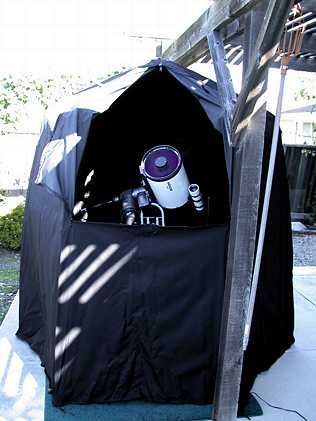
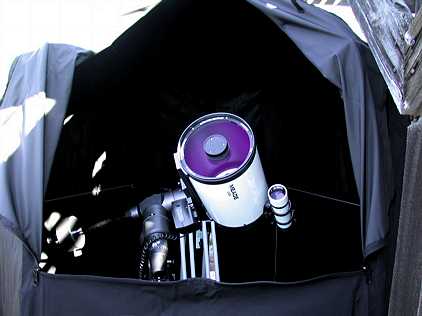
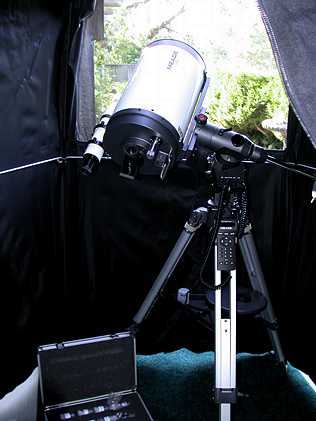
As I mentioned, I had a lot of problems with GOTOs. Alignments were OK but GOTOs were off by several degrees. One time it even pointed below the horizon. Once it would not do any slewing to the east in RA. Tried several alignments, a RESET, a reTRAIN, all to no avail. Even tried improving the polar alignment several times, all with no improvements in GOTOs. I also discovered that my DEC scale is off by 10 degrees; that doesn't bother me much as I just usually eyeball the HOME position. Seems like I have some tuneup work to do.
I was able to take more astrophotos of Saturn. See my Astrophotography - Planets page.
[1/09/03]
Due to all the problems I had with GOTOs and tracking (mentioned on the 1/03 update), I decided to RESET, RECALIBRATE, and reTRAIN the drives. I checked the telescope model and it was ETX-125EC!!! So, now the light comes on: I had cloned this Autostar from the updated Autostar that was connected to my ETX-125EC. I had thought I had set up everything correctly before the last use but something must have been missed. And yes, when I did the Easy Align I was prompted to put the telescope in the GEM Home Position! So I set the Telescope model to LXD55 8"SC. I put the telescope back in the GEM Home Position and did a RESET and RECALIBRATE. I then TRAINed both drives using Polaris. All GOTOs were within the finderscope (not bad considering my rough Polar Alignment). I then checked my RA tracking. I centered a star near the equator in the 6.4mm eyepiece and after about 10 minutes it was still centered. I'm happy with that!
I looked at the Double Star Cluster using the 40mm eyepiece: nice with some star colors evident. M31 was pretty in the 40mm as well.
While I was out I took some photographs of the crescent Moon before it got too low in the sky. Those are on My Moon page.
A much more successful night than the last time. Whew.
I ordered an 8" SCT AstroZap Starfield Dew Shield ($36) from Scopetronix. It is a wrap-around style designed for Meade 8" Schmidt-Cassegrain Telescopes. Super, that is what I have (my thinking when I ordered it). When it arrived I discovered one flaw in my logic: the OTA mounting bracket for the LXD55 8"SC runs the length of the OTA, thereby interferring with a good fit with dewshield.
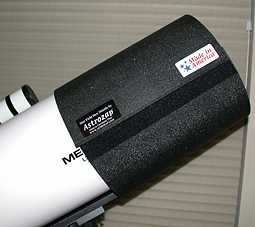
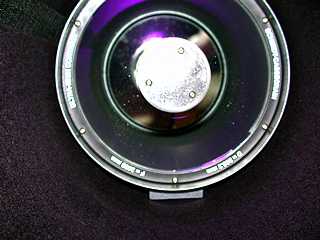
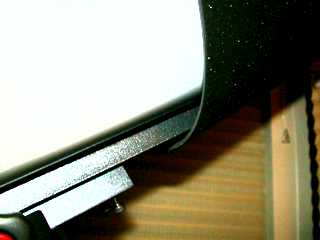
I made a velcro "belt" to wrap around the dewshield when attached to the OTA (not shown in the photo on the left above). It also holds the rolled-up dewshield together for storage when not in use.
The dewshield is still functional and doesn't fall off the OTA as the telescope slews around. There is a rubber strip on the inside to help grip the telescope tube. The inside is a nice flat black, as can be seen in the photo.
[1/29/03]
I have two updates to items discussed above.
While taking down the Clear Nights Products TeleDome I discovered some small white pieces of plastic on the patio. It turns out that these were from the washer at the top hub of the TeleDome. I have updated my comments on the TeleDome page on my ETX Site.
Astrozap sent me a modified dewshield with a cut-out for the LXD55 8"SC mounting bracket. The fit is excellent. I still find it necessary to secure the shield with a wrap-around velcro strip (the tan "belt" in the photo). The need for this may go away after some use; the problem is that when new the material wants to be flat and not in a tube. The velcro on the dewshield barely holds the ends together; adding the belt makes a more secure dewshield.
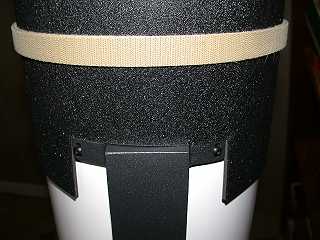
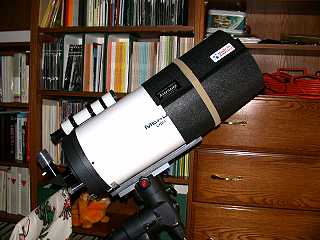
The model number for the shield is be 8-SC. The price is slightly higher than the standard 8" shield because of the extra labor for the notch: $39.50.
Return to the top of this page.
Go to back to my LXD55 Home Page.
Go to Weasner's Mighty ETX Site.